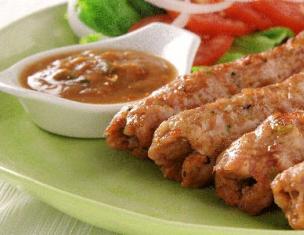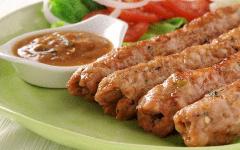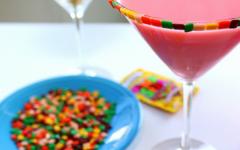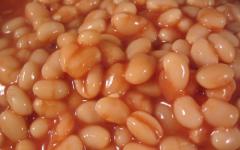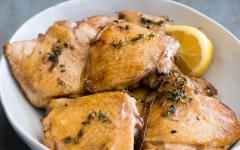No type of store-bought alcohol compares to homemade alcohol. After all, homemade tinctures are prepared with love and exclusively from natural products. One of the most delicious and aromatic homemade alcoholic drinks is slivyanka (plum tincture). How to make slivyanka without vodka and with vodka?
Ingredients
Plum 1 kg Sugar 300 grams Vodka 500 milliliters
- Number of servings: 1
- Cooking time: 1 minute
Slivyanka recipe with vodka
The easiest way to prepare slivyanka is with the addition of vodka. You can put various additives in it, for example, mint or cinnamon. But let's look at the classic, basic recipe for this drink.
Ingredients:
- 1 kg plums of any type;
- 300 g sugar;
- 500 ml vodka.
First of all, prepare the plums: wash them, remove the seeds, cut them into small cubes. Place the raw materials in a bottle, fill with vodka, cover with a lid and put in a dark place for a month.
After the specified time, drain the workpiece through cheesecloth. Leave the cream in the bottle, add sugar, cover, shake and leave for another week. After this, drain the resulting syrup, place the plums in cheesecloth and squeeze well. Combine the 2 pieces, cover with a lid and let brew for another 1 month. If you want the drink to be light rather than dark, additionally pass it through cotton wool.
Slivyanka at home without vodka
This recipe will make a strong and sweet plum wine. Strength is achieved solely through natural fermentation.
Ingredients:
- 6 kg plums, pitted;
- 2.8 kg sugar;
- 3 glasses of clean water.
Place plums, sugar, cut into several pieces, into a large container, add water and mix all ingredients thoroughly. Tie the neck of the container with gauze and put it in a warm place for a couple of days. Make sure that the room temperature is around 18-25°C.
As soon as foam and bubbles appear on the surface of the liquid, put a regular rubber glove on the bottle and make a hole in one finger.
The tincture will take 20-30 days to prepare. Once the glove is deflated, the fermentation process is complete. After this, you need to filter the drink using gauze and cotton wool. Pour the resulting plum into bottles and store in a cool and dark place for 2 months. After this time, you can taste the delicious aromatic drink.
Do not throw away the plums left after preparing the tincture. They can be used as mash for moonshine. In addition, the plums left over from the alcohol tincture can be dried and served as an unusual dessert. Of course, such a dessert is only suitable for adults, not children.
13335
When a citizen of Prague sets out on his journey to Turnov,
the whole family gathers around him, all his acquaintances,
and he, looking into the travel suitcase, says to his wife:
-Old woman, how many cutlets did you give me? Did you forget the sausage?
Is there a bottle of Slivovitz there too?
Jaroslav Hasek "The Adventures of the Good Soldier Schweik"
Slivovitz, also known as slivyanka or rakia, is a strong alcoholic drink, widespread in many Balkan countries and the Czech Republic, and is considered the national drink of Serbia. In the above countries, rakia (slivovitz) is the same source of national pride as cognac and Armagnac in France, whiskey in Scotland and Ireland, and vodka in Russia.
The raw material for producing strong brandy is fermented plum juice. From time immemorial, the Balkans were famous for their plums. They were eaten fresh, used as filling for pies, and made into jam, marmalade, and compotes. It was only in the 16th century that some alcoholic genius came up with the idea of making moonshine from fermented plums. History says that the appearance of a strong drink created a real sensation among the Balkan peasants. The nobles decided to rein in the unruly mob, went all the way to the emperor himself and achieved an official ban on moonshine brewing. No such luck! “Rakija oven”, which is what the moonshine brewing process is called here, has become ubiquitous in the Balkans.
There are also a lot of plums in Serbia. There is no yard where a plum tree does not grow. Recently, at international tourism fairs, Serbian stands are decorated in plum color, visitors are treated to prunes, plum brandy, and are given plum and walnut jam as a souvenir. In Serbia, many villages got their name from these fruits, for example, Šlivar, Šlivovo, Šlivovac, and the village on the slopes of Zlatibor is called Šlivovitsa. Rakia according to a recipe from the village of Šlivovitsa received a European Community certificate in 2007 under the name “Serbian rakia slivovica”.
Rakia was first prepared there in 1868. The village has about 500 houses and a little more than a thousand inhabitants. They all prepare rakia for their own consumption.
Plum is the most common type of fruit in Serbia. It is estimated that there are 42 million plum trees in Serbia, i.e. half of the total number of fruit trees that grow on our territory. The domestic plum was created as a result of crossing two plants - sloe and cherry plum, and the number of varieties created in this way in Serbia exceeds 2 thousand. In the 19th century, Serbia was an important exporter of jam to England, and today prunes are the most exported country, particularly to Russia, France and Germany. But most of all fresh plums are, of course, processed into brandy.
In some places in Serbia, the custom of serving a glass of slivovitz as a treat along with coffee and Turkish delight has been preserved, and events, both happy and sad, are not complete today without this drink.
How to drink slivovitz?
 The strength of this drink reaches 45%. For those who like it hot, there is another option - double-distilled slivovitz, the strength of which is already 75%, and is called “prepechenica”. The aging time of slivovitz, again, is not for everyone. Slivovitz can be drunk as soon as it is ready. But experts say that it is better to wait five years, aging it in oak barrels. That’s when the drink acquires a deeper and richer aroma of plum, as well as its distinctive noble yellow color.
The strength of this drink reaches 45%. For those who like it hot, there is another option - double-distilled slivovitz, the strength of which is already 75%, and is called “prepechenica”. The aging time of slivovitz, again, is not for everyone. Slivovitz can be drunk as soon as it is ready. But experts say that it is better to wait five years, aging it in oak barrels. That’s when the drink acquires a deeper and richer aroma of plum, as well as its distinctive noble yellow color.
Slivovitz is consumed in its pure form, because it is almost impossible to prepare any cocktails based on it. When mixing this drink with various sweet and sour juices or alcoholic drinks, an unpleasant metallic taste is created. Therefore, practically the only pretty good option is a combination of slivovitz with Midori liqueur.
It’s pleasant to drink as an aperitif; it’s not customary to eat the first glass, but you can eat the second with a slice of toasted cornbread.
The temperature of slivovitz can be any: room temperature, slightly chilled or, in the Czech style, slightly warmed up and even very hot. Serbian peasants are sure that slivovitz helps literally against all diseases.
Slivovitz recipe
The ripest plums are placed in a mortar and pounded together with the seeds to obtain a liquid pulp, which is poured into a barrel and a little water is added. After some time, the mass will begin to ferment. At the end of fermentation (the liquid stops fizzing), the wort is filtered, poured into a still and distilled several times in order to remove fusel oils and bring the slivovitz to the desired integrity.
Excessive alcohol consumption is harmful to your health!
Slivovitz is a plum brandy, another name for this alcoholic drink, rakia, widespread in all Balkan countries, as well as Slovakia, the Czech Republic and Hungary. National drink of Serbia, Macedonia, Bulgaria, Bosnia and Herzegovina, Croatia.
It is the Serbian moonshiners who say: “In the kingdom of alcoholic beverages there are two kings - Scotch whiskey and French cognac, and only one queen - Serbian plum brandy.”
Slivovitz, also known as rakia, is nothing more than plum brandy and its preparation technology is similar to chacha and grappa, only the raw material used is different - fermented plum juice.
The strength of slivovitz after the first distillation is about 45% (at home it reaches 52%), and with double distillation it is approximately 75%. The Czechs prefer triple distillation.
Slivovitz is usually aged for at least 5 years in oak barrels, during which time the drink becomes more refined and rich in taste.
Our land is rich in plums, and the fruits will soon ripen, so making plum brandy at home is possible and even necessary.
We will describe the classic recipe for slivovitz, the main difference of which from most other recipes is the absence of sugar and yeast in the wort - they impoverish the drink in taste and smell, and the alcohol itself is of poorer quality.
Recipe for slivovitz (plum brandy)

The main two ingredients in making the drink are ripe sweet plums and clean water. If the plums were ripened during the rainy season and their sugar content is very low, then it is difficult to do without adding sugar. In this case, sugar must be added carefully, slowly, the amount needed is as small as possible, otherwise the plum wine will turn into a simple fruit mash for moonshine.
So, we will need:
11-12 kg of plum fruits;
8-9 liters of clean water;
sugar (the amount depends on the sweetness of the plums);
2 fermentation tanks.
The cooking technology is not complicated and consists of several main steps:
Preparation of fruits.
Setting up the wort for fermentation.
Fermentation.
Distillation.
Infusion.
Preparing fruits for plum brandy

Any variety of sweet plums is suitable for making plum brandy. The fruits should be collected as late as possible, when the plums become most sugary (optimal sugar content 8-9%).
The plums should be as ripe and juicy as possible, but not wrinkled around the cuttings. We do not collect spoiled or wormy fruits.
There is no need to wash plums, since their surface contains natural yeast cultures, the so-called wild yeast (it is enough to lightly wipe the surface with a thick cloth). The fruits need to be pitted, dividing them into two halves, then crushed or mashed using a meat grinder or crusher to a homogeneous pulp. It is also recommended to add 15-20% crushed seeds to the main wort - they will give the drink a bitter almond flavor.

Setting up the wort for fermentation

In a fermentation container, you need to place a pulp of crushed plums. For such containers, you can use buckets and barrels made of food-grade plastic, which are now easy to buy.
If the wort does not seem sweet enough, and here you can be guided by your taste sensations or the readings of a hydrometer (sugar meter), it can be sweetened. Just add 100-200 g of sugar until the optimal sugar content is reached - 8-9%.
The fermentation container must be covered with gauze and sent to a warm place for a day to allow the fermentation process to begin. If everything went as it should, foam will begin to form on the surface. If fermentation has not started after 24 hours, you can try adding a little more sugar and wait 12 hours.
After fermentation begins, the wort must be poured into another fermentation container, a 20-30 liter glass bottle and pure spring or distilled water added. In this case, the container should be filled no more than 4/5 of the total volume, since the wort will actively foam. Mix thoroughly and install a water seal on the neck. Now let's move on to the next stage.
Fermentation of plum wort
The fermentation container with our mash should be placed in a dark place and protected from sunlight and temperature changes. The ideal fermentation temperature is +15°C, but at home you can bring it to the optimal +20...22°C. On average, the wort ferments for 2-4 weeks at +20...22°C, at +15°C - 6-8 weeks.
During fermentation, carbon dioxide is actively released, which “boils” the wort and thereby stirring it (stirring the wort yourself is strictly prohibited). Gases also raise crushed fruits to the surface, forming a foamy “cap”. This “cap” must be removed from the wort before it sinks to the bottom - this will be clearly visible if the container is glass. Plum wort contains many harmful impurities, in particular light acids and fusel oils. After carbon dioxide has ceased to be released from the water seal, you should immediately begin distillation.
Distillation of slivovitz
The wort must be distilled at least twice. To do this, we pour the fermented wort into the distillation cube of the moonshine still and drive it “to dryness,” that is, until there is no more alcohol in the distillate. During the first distillation, you should not cut off the “tails” and “heads,” since they, and especially the “tails,” contain many aromatic fruit substances, the boiling point of which is the same as that of fusel oils. However, the heads can be cut off, but in the Czech Republic they do not use fractional distillation at all.
The second distillation must be carried out with cutting off the “heads” and “tails”, while the raw alcohol obtained after the first distillation should be diluted to 25-35%. More information about the fractional distillation process is described on our website. The second time must also be distilled “to dryness”; the “heads” in the Balkans are used for medicinal purposes; the “tails” can be added to the next distillation. If you follow this recipe, then the heads should be approximately 100-150 ml, the main product - 1-1.5 liters, and the tails - about 200 ml. After double distillation, the strength of slivovitz will be about 55-60%. You can drink it like that, but it’s better to dilute it to the optimal 45%.
You can buy it on our website.
Infusion, ripening of slivovitz
Slivovitz is aged in oak barrels and if you have such an opportunity, be sure to take advantage of it. In Serbia, 100 kg of plums yield an average of 10-11 liters of slivovitz, so you will need quite a few fruits. Give the drink a rest, the more the better. When kept in an oak barrel for a long time, slivovitz acquires a unique aroma and refined taste.
Plum is a fruit with a pleasant sourness, which makes excellent desserts, baked goods and various wines, tinctures, and liqueurs. For those who prefer to prepare alcoholic drinks on their own, we present several simple recipes for plums at home. Depending on your preferences, you can get low-alcohol and strong liqueurs. Any fruit is suitable for making drinks, but the most delicious liqueur is obtained from red sweet plums, varieties “Hungarian”, “Renklod”, “Canadian”. Of the yellow varieties, the Mirabelle plum is the best.
Preparation of plums
Before you make plum at home, you need to properly prepare the fruits. The quality of the drink will depend on this.
To prepare homemade plum liqueur or tincture, it is better to take slightly overripe fruits. But they should not be too ripe, otherwise the high pectin content will turn everything into a jelly-like mass.
Slivyanka recipes
There are different recipes for liqueurs made with plums: sweet and not so sweet, strong and light. Let's look at the best ways to prepare plums.
Classic recipe for slivyanka without vodka
In this recipe, it is better to remove the pits from the plums. It is recommended to take red varieties of plums.

You will need:
- Peeled plums – 6 kg.
- Granulated sugar – 2.8-3 kg.
- Water – 3 glasses.
Cooking instructions:
- Cut the plums into slices, cover them with sugar, add water and mix everything thoroughly. When the sugar has melted, pour the mixture into a previously prepared glass bottle.
- Seal the neck of the vessel with a breathable material: bandage, gauze, light, clean cloth.
- Place the container in a warm, dark place for 2-3 days.
- After the specified period of time, the fermentation process should begin. This will be noticeable by the resulting foam and sour smell. The fabric stopper must be removed and a water seal must be placed on the neck of the vessel. In home preparation, ordinary medical gloves are often used as a water seal. You need to make a small hole on one finger for air to escape. Wearing a glove, put the container back in a dark place.
- Once the fermentation process is complete (the glove is deflated), filter the liquid and separate the wort.
- Pour the resulting transparent liqueur into bottles and send it to mature in a cellar or other dark and cool place for 2 months. After the expiration of the term, the plum is ready.
Plum liqueur prepared without vodka is not very strong (about 16 degrees). It has a pleasant sweetish taste with sourness and a pronounced plum aroma. If you prepare homemade liqueur without yeast with seeds, then notes of bitterness will appear in the taste.
This drink can be served with white meat, cold appetizers and desserts. Unopened bottles can be stored for up to 2 years. Opened plum can be stored in the refrigerator for no more than 10 days.


Vodka recipe
Slivyanka with vodka cooks faster. This method is suitable for those who like stronger alcoholic drinks. Plums can be used either peeled or with pits.
Ingredients:
- Ripe plum – 1 kg.
- Vodka – 400-500 ml.
- Granulated sugar – 350-400 g.
Prepare in advance clean glass jars in which you will make the liqueur.
On a note! The entire process of preparing homemade plum must take place under sterile conditions.
Cooking instructions:
- Rinse and dry the plums. If they are large, you can cut them into 2-4 parts.
- Place the fruits in layers, covering each layer with sugar.
- Cover the filled jars with gauze and put them in a dark, warm place for a day or two.
- During this time, the plum should give juice. To ensure that the fruits are completely saturated with it, the containers need to be shaken every 4-5 hours.
- After 2 days, pour vodka into the containers so as to fill them to the brim.
- Seal the jars with lids and store in a cool, dark place for 1 month.
- After this, uncork the containers, strain the tincture, separating the fruits, and pour the filtered liquid into bottles. Slivyanka is ready to eat.
This homemade recipe for plum cake with sugar and vodka can be modified as you wish. To obtain a sweeter liqueur, increase the amount of sugar. You can also add some berries and spices to the plums for aroma and rich taste. If you don’t have vodka, it’s quite acceptable to make a plum liqueur using moonshine. The tincture can be stored for a year in well-sealed bottles.


Bitter-sour plum
Not everyone likes sweet alcoholic drinks. For those who appreciate tart liqueurs with bitterness and sourness, the recipe below is suitable. Unsweetened plum is prepared at home, also with vodka. You can replace vodka with diluted alcohol or moonshine. In this recipe, it is very important that the plums are ripe and not too sour, otherwise the drink will not be very pleasant.
You will need:
- Plums – 1 kg.
- Vodka – 400-500 ml.
Cooking process:
- Rinse the plums, make cuts on them; there is no need to peel them.
- Place the fruits in jars and fill with vodka.
- Seal the containers with lids and put them in a cool, dark place for 1.5 months.
- After the expiration date, filter the contents of the jars. Pour the resulting liqueur into bottles. Slivyanka is ready and can be consumed immediately after pouring.
The drink is ideal with meat dishes, salads, and vegetables. Unsweetened plum liqueur can be stored at home for no more than 1 year in a hermetically sealed container.
Strong alcohol-based plum

 Those who like stronger drinks can make slivyanka with alcohol, diluting it to the desired degree. The alcohol must be pure, preferably medical grade. It is best to prepare this liqueur from yellow plums.
Those who like stronger drinks can make slivyanka with alcohol, diluting it to the desired degree. The alcohol must be pure, preferably medical grade. It is best to prepare this liqueur from yellow plums.
Ingredients:
- Plum fruits – 2 kg.
- Alcohol (96 or 70 degrees) – 1 glass.
- Sugar – 500 g.
- Fresh mint – 3-4 sprigs.
How to cook:
- Peel the plums and grind them into puree using a blender or meat grinder.
- Mix the puree with sugar, add mint leaves and pour alcohol over everything.
- Divide the mixture into jars, seal them with lids and store in a cool, dark place for 30-35 days.
- Afterwards, strain the plum through several layers of gauze or cotton wool.
The liqueur turns out to be thick, tart and very tasty, despite its high strength. It can be diluted when serving, and also added to tea and coffee in winter. This tincture can be stored for a long time - 3-4 years.
Jam plum recipe
If you have leftover plum jam, you can use it to make a wonderful, sweet-tasting alcoholic drink.
Preparing this liqueur is somewhat labor-intensive, but the taste is excellent.
Products:
- Plum jam – 1 l.
- Vodka – 1.5 l.
Home manufacturing technology:
- In a convenient container, mix the jam with vodka until you get a homogeneous mass.
- Pour the resulting liquid into clean jars, close them with lids and put them in a warm place to ferment for 6-7 days. You need to shake the jars every day.
- After a week, move the containers to a cool, dark place and leave them for another 3 days, continuing to shake.
- After time, carefully drain the separated liquid. The sediment should remain at the bottom. To make it transparent, filter through several layers of gauze.
- If the sweetness is not enough, add sugar to the tincture and stir until completely dissolved.
- Pour the liquid into bottles and store in a cool place for another 3-7 days. The longer the plum is infused, the better its taste will be.
The resulting liqueur can be stored for up to 3 years in an airtight container. The opened drink should be kept in the refrigerator for no more than 2 weeks.
Now you know how to make delicious homemade liqueur with plums of varying strengths and sweetness. Choose the most suitable recipe and enjoy the fruity alcoholic drink.
You may have brought it to friends from the Czech Republic, or, conversely, received elongated or squat bottles of slivovitz as a gift: this is a national Czech brand. Czech plum brandy is called the queen of alcohol (by analogy with the recognized kings - Scotch whiskey and elite cognacs from France).
But despite all the advantages of the drink, we have to admit that it’s just plum moonshine, and it won’t be difficult to make plum brandy at home.
Slivovitz recipe
To answer the question of how to prepare slivovitz, the process can be briefly described as a sequence of actions: preparation of raw materials, preparation of wort for fermentation, fermentation, double distillation, aging in an oak barrel.
- Prepare the raw materials. These are ripened plums (unripe ones do not contain the amount of sugar required by technology) of a cultivated garden variety. The slivovitz recipe allows the use of only cultivated fruits. They must be carefully sorted through, rejecting those affected by rot, worms, mold, dry, greenish and very dirty carrion.
Plums that fall from a tree are the sweetest and most juicy; they work great, but only if they fall on clean grass or dry ground. The fact is that real plum is prepared from unwashed fruits using a yeast-free method, using wild yeast present on the peel.
- Halve the fruits and select the seeds, mash into a juicy, homogeneous porridge. It is permissible for a small amount of ground seeds to get into the wort - for a piquant taste and almond bitterness.
- Pour the wort into a fermentation container. If you are preparing classic slivovitz, the recipe involves using wooden containers - barrels and vats, but you can use glass or modern plastic ones. Cover with a cloth (gauze) and keep warm for a day before the fermentation process begins. If foam does not appear as a sign of fermentation, add sugar and let stand for another 12 hours. Add a little water to the fermented mash to reduce the acidity, and leave it to ferment under a water seal for one and a half to two months.
- Fermentation occurs with the active release of carbon dioxide, the rising gas brings foam with particles of pulp to the surface, you need to stir once a day.
- We distill twice, the second time cutting off the heads and tails will make the product pure, with a recognizable taste and aroma. We dilute it to a strength of 40 degrees; if you are going to keep it in a barrel, it’s better to reach 45-55 degrees.
- Soak the resulting moonshine in an oak barrel for a month or two. The product is good even without aging, but the connoisseur will wait until it is fully ripened, when the flavor bouquet acquires sophistication and richness of aromas.
How to drink slivovitz correctly
Slivovitz is great as an aperitif. You can’t immediately eat the first glass you drink (you can already take the second one); take a gourmet break and catch all the taste and aroma. Drink in its pure form, do not mix with other drinks. We recommend eating plum brandy with meat, potatoes and toasted cornbread.



